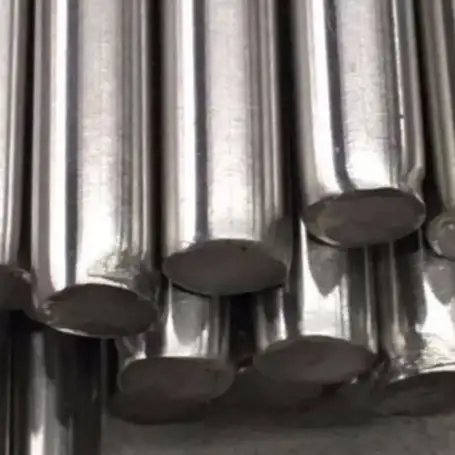As of mid-2025, finished Hastelloy® C-22 (UNS N06022) typically trades in the range ~USD $50–$140 per kg depending on region, product form (sheet/plate, bar, seamless pipe), certification and order quantity — with China/form-stock offers often at the lower end of that band and Europe / USA finished-certified product toward the upper end. These ranges reflect alloying costs (nickel/molybdenum), fabrication & certification premiums and recent market softness after a 2024–early-2025 cooldown.
What is Hastelloy C-22 (UNS N06022)?
Hastelloy C-22 is a high-nickel, nickel-chromium-molybdenum-tungsten superalloy formulated for extreme corrosion resistance in both oxidizing and reducing environments. Nominal chemistry includes ~56% Ni (balance), ~22% Cr, ~13% Mo with additions of Fe, W and small Co — making it superior in pitting, crevice corrosion and stress-corrosion cracking resistance vs many other Ni-Cr-Mo alloys. Typical referenced manufacturer/technical documentation and product brochures should be consulted for full certified composition and permitted tolerances.
Why this matters for price: C-22’s heavy noble/alloying content (notably nickel and molybdenum) is the largest raw-material cost component; welding, mill certification (NACE, EN, ASTM) and traceability add further premiums.
Typical material forms and applications
Common supply forms include:
-
Plate / sheet / coil (common for reaction vessels, tank linings)
-
Round bar / rod (shafts, fittings)
-
Seamless & welded pipe and tubing (heat exchangers, process piping)
-
Forgings, flanges, fittings and fasteners
-
Powder & wire (for additive manufacturing or specialized welding electrodes)
Applications: chemical process equipment (sulfuric / phosphoric acid), waste treatment, marine / seawater systems, flue-gas desulphurization, pharma and power generation. Supply form and required finishing (cold-rolled sheet vs hot-rolled plate vs forgings) materially change the unit price per kg.

How sellers price Hastelloy C-22 (what composes the per-kg cost)
Sellers typically break down per-kg pricing into:
-
Raw alloy cost — dominant (proportional to nickel and molybdenum market prices).
-
Processing & yield loss — melting, forging, rolling, heat treatment, machining.
-
Certification & testing premium — mill test certificates (EN 10204 3.1/3.2), NACE MR0175, PED, etc. Certified/traceable product typically carries a premium.
-
Form & dimensional effects — thin strip vs heavy plate vs small-diameter seamless pipe — costs differ due to production difficulty and scrap.
-
Order quantity & lead time — larger lots and standard stock sizes lower the per-kg.
-
Logistics, tariffs and regional taxes — shipping, duties and local levies add landed cost.
-
Seller margin & service — pick-and-pack, cut-to-size, surface finish, and warranty/after-sales support.
Practical note: FOB factory quotes for standard bar/plate from Chinese producers are commonly lower than DELivered, certified finished components from Western distributors because the latter includes additional inspectors, documentation and local warranty obligations. See supplier price samples for manufacturer FOBs vs distributor DEL prices.
Historical price summary — past 5 years (201–2025 focus)
Method note: the table below aggregates market reports, supplier lists and industry price indexes (seen in the referenced sources) to form approximate average annual benchmarks. Actual transaction prices vary by form, quantity, certification and destination.
Table A — Approximate average annual price of finished Hastelloy C-22 (USD per kg, aggregated average across common forms)
| Year | Approx. average (USD/kg) | Market context / drivers |
|---|---|---|
| 2021 | $30 – $45 | Post-COVID recovery; nickel rally begins; supply tightness in specialty alloys. |
| 2022 | $40 – $60 | Rising nickel & moly prices; increased demand in chemical & desalination projects. |
| 2023 | $55 – $75 | Continued alloy raw-material pressure, logistics premiums. |
| 2024 | $60 – $95 | Peak volatility as supply chain normalization met regional demand spikes and limited mill capacity. |
| 2025 | $50 – $140 (range by region/form) | Market softened in Q1–Q2 2025 in some regions but certified finished product remains at premium; regional spreads widen. |
Interpretation: the band is wide because form and certification swing per-kg pricing heavily. For example, thin sheet/coil bought FOB China in volume can be quoted at a substantially lower per-kg than small certified flanges delivered in Europe. Historical increases largely correlate with LME nickel and molybdenum movements and constrained specialty alloy mill capacity.
Global price table for 2025
Table B — Representative 2025 regional price ranges (USD per kg) — typical finished product ranges, mid-2025 snapshot
| Region | Sheet / Plate (USD/kg) | Round bar / Rod (USD/kg) | Seamless pipe / fittings (USD/kg) |
|---|---|---|---|
| China | $40 – $95 | $45 – $105 | $50 – $110 |
| Europe | $80 – $130 | $85 – $135 | $95 – $140 |
| USA | $90 – $140 | $95 – $145 | $100 – $150 |
| India | $35 – $90 | $40 – $95 | $45 – $100 |
Sources & basis: consolidated supplier FOB lists and independent alloy price summaries indicate China tends to show lower FOB quotes while Europe/USA delivered certified products trend higher due to labor, certification and logistics. The ranges above reflect common market quotes published by suppliers and alloy price trackers in 2025.
Caveat: Single small orders, unusual diameters or very high-spec certifications (e.g., nuclear, NACE MR0175 + full traceability & special heat treatment) will fall at the top or exceed these ranges.
Market drivers detailed factor analysis
-
Nickel price (LME) — majority raw-material driver. Nickel movements explain much of the C-22 price volatility. Finished-product multipliers over raw Ni are typical because of alloying content and processing. Recent LME movements in early 2025 averaged roughly $15,000–$15,700/tonne (~$15–$16/kg) which materially underpins base metal cost.
-
Molybdenum & tungsten pricing. Moly is expensive relative to iron; alloys with 10–15% moly (like C-22 with ~13% Mo) are sensitive to molybdenum price spikes which add several dollars per kg.
-
Mill capacity & lead times. Specialty alloy melt slots and certified mill production are constrained; longer lead times push buyers to accept higher spot prices or premiums for prioritized production.
-
Certification & testing premiums. NACE, PED, EN/ASTM test certificates, hardness/UT/PMI tests, and 3.1/3.2 paperwork add direct cost and overhead (inspection witness, extra heat treatment), often expressed as $/kg or a flat surcharge per order.
-
Tariffs, trade policy and duties. Recent 2025 trade actions and tariffs on nickel-based alloys in certain markets have raised landed costs materially in some jurisdictions, especially for fully finished imported goods. Buyers sourcing internationally must model potential duty percentages into their landed price.
-
Form & scrap yield. Small-diameter or thin gauge sizes can increase scrap and machining losses, elevating per-kg effective cost.
-
Logistics & freight. Ocean freight spikes and insurance (esp. on heavy, high-value loads) add a per-kg landed uplift; incoterms matter (FOB vs DAP/DEL). Global freight volatility since 2020 remains a relevant factor.
-
Inventory & distributor markups. Distributors holding certified stock take inventory risk — that cost is passed to buyers as higher per-kg pricing versus direct mill FOBs.
Forecast: 2025–2035 outlook (5–10 year view)
Base scenario (most likely, mid-case): slow, steady growth in specialty alloy demand (chemical, wastewater, renewable energy, industrial decarbonization equipment) with a CAGR for Hastelloy family around 3–5% through 2030. Price volatility will continue, but structural demand and limited high-quality mill capacity will sustain premiums on fully certified finished goods.
Upside scenario: accelerated global projects (desalination, petrochemical rebuilds, green hydrogen electrolysis plants) + constrained nickel supply could push prices well above 2025 highs for 1–3 years.
Downside scenario: substitution (where cheaper alloys suffice), increased scrap recycling, or significant nickel supply additions could depress spot raw material costs and reduce finished product prices toward the low end of historical bands.
Key takeaways for procurement planning:
-
Use multi-year contracts or hedged supply agreements for predictable pricing.
-
Build spec flexibility where possible (allow alternative acceptable forms or finishes).
-
For critical long-lead components, prioritize proven supplier capacity and documented traceability over the cheapest per-kg quote.
Procurement & cost-saving strategies
-
Buy standard stock sizes where possible. Non-standard dimensions increase yield loss and per-kg cost.
-
Consolidate orders to reach mill-lot quantities (5+ tonnes often unlock bulk discounts). Several Chinese producers advertise bulk discounts at 5-ton+ levels.
-
Consider FOB mill purchases for large, non-certified applications, and pay for third-party inspection only if needed.
-
Specify only necessary certifications — avoid over-specifying tests that add cost but do not improve in-service safety.
-
Use trusted Chinese mills for factory price advantage if you can accept FOB and manage QC locally. MWAlloys (China) offers factory pricing, custom machining, and can support mill certificates and third-party inspection — an option for buyers seeking lower landed cost combined with custom services.
Quality, standards and tests buyers should insist on
-
Standards: ASTM B575 (plate/sheet), ASTM B622 (pipe), ASTM B619 (forgings) — confirm applicable standard for the form you order. Manufacturer Haynes documentation is the reference for UNS N06022 properties.
-
Certificates: EN 10204 3.1/3.2 or equivalent mill test reports, PMI (positive material identification), non-destructive testing where required (UT, radiography).
-
Traceability: full heat-no → mill → delivery chain recorded.
-
Third-party inspection: for critical applications, an independent inspector (BV, DNV, SGS, Intertek) should witness chemical analysis and mechanical testing.
-
Welding & fabrication guidance: review Haynes/C-22 welding recommendations to avoid weld-H.A.Z. issues and confirm post-weld heat treatments if process requires.
FAQs
-
What is the cheapest way to buy Hastelloy C-22?
Buy standard stock forms in large lots FOB from a mill (e.g., Chinese mill), accept basic certification, and manage inspection locally. Bulk orders (5+ tonnes) usually reveal per-kg savings. -
Does price differ by form (plate vs pipe vs bar)?
Yes, seamless pipe and heavy forgings usually cost more per-kg than plate/sheet due to manufacturing difficulty and scrap. -
How much does certification add to price?
It varies: full NACE/3.1/3.2 documentation plus witnessed tests can add a fixed surcharge or 5–20% depending on order size and inspection needs. -
Is Hastelloy C-22 magnetic?
No. C-22 is an austenitic nickel alloy and is non-magnetic in the annealed condition. -
How sensitive is C-22 price to nickel LME?
Very sensitive — nickel forms the bulk of alloy mass; LME swings translate directly into base cost. For 2025, LME averages informed base cost estimates for finished product. -
Can I substitute C-22 with C-276 or 625?
Only after metallurgical and corrosion suitability analysis; C-22 often outperforms C-276 in mixed oxidizing/reducing environments. Substitution may reduce cost but must meet service conditions. -
What is a realistic lead time?
For mill stock items, 2–6 weeks; for custom forgings or large certified orders, expect several months. Lead time impacts price and availability. -
Do Chinese suppliers provide full mill certificates?
Reputable Chinese mills supply EN/ASTM certificates and can accept third-party inspection; always verify with PMI and document checks. -
How to calculate landed cost?
Sum FOB price + freight + insurance + import duty + local handling + inspection & testing fees + VAT (if applicable). Model scenarios for best comparison. -
Will prices return to pre-2021 levels?
Unlikely for certified finished product — structural demand and specialized manufacturing keep the long-run floor above pre-2021 levels; raw metal corrections can produce temporary dips. Market reports project steady demand with modest CAGR.
How MWAlloys can help?
-
Factory price advantage: MWAlloys operates mill relationships and offers FOB factory pricing on plate, bar and pipe. For buyers prioritizing unit cost over immediate local presence, this reduces landed cost.
-
Customization & services: cut-to-size, CNC, weld prep, custom forgings and small-lot machining available.
-
Documentation & inspection: full mill test certificates supplied; third-party inspection and witnessed testing arranged on request.
-
QC: incoming PMI, chemical & mechanical tests, packaging to export standards.

